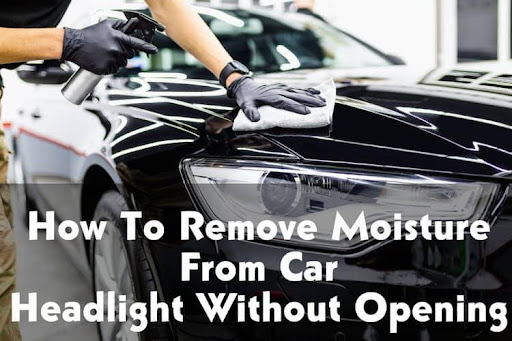How to remove moisture from car headlight without opening the component may sound like an impossible question, but there is always a way for every will.
Finding a headlight with light to heavily dense condensation gives the driver an exhausting, time-consuming problem to fix.
But, as the tool which allows its passengers to look ahead in the dark, it is important that there is nothing that could stand on its way to doing what it must.
When and Why My Car Headlight Gets Moisture?
To know how to get the moisture out of the headlights, you need to know why it happened.
There are different causes for a headlight to form condensation, but it can be broken down into two reasons.
First, it could be that the ventilation of your headlights has been blocked.
This traps the hot air which is produced by the housing and won’t allow cool air to come in and cool the fixture.
But if it’s not the first reason, it could be that a seal for the headlight has been torn or cracked.
This causes water to come inside.
01. Required Time
Depending on the method used and the conditions of your environment, removing condensation from the headlight can take up to more or less 15 minutes to a whole day.
The level of condensation must also be taken into account as not all levels can be removed at the same amount of time.
02. Cost
Removing moisture from a car headlight can cost up to nothing at all up to $200.
For the price, expect it to depend on the method you’re using with the level of moisture in the headlight.
03. Tools
The tools you can use for removing the moisture are:
- Hairdryer
- Pressurized air blaster
- Silica Gel Packets
- Silicone Adhesive/Sealant
- Socket Wrench Set
Minor Condensation Removing Ways
01. Leaving it Be
They say that time is able to heal wounds, but time can also help the minor-leveled moisture in the headlights disappear on its own.
This is particularly true if the weather and temperature conditions are in the driver’s favor, but it still requires patience.
Step 1
If the moisture isn’t too much of a big deal, simply keep the headlights turned on.
This is because having the bulbs of the headlights generates heat which can evaporate the condensation.
Step 2
If that doesn’t work and the driver doesn’t want to risk draining the car’s battery, placing the vehicle under the sun can also effectively rid the headlights of any moisture.
Be Warned
This method will cause the passengers to experience uncomfortable temperatures once they enter the turned-off car.
This can be avoided by slightly rolling the windows down to release the trapped heat.
02. Hairdryer
As this everyday item is used to rid the dampness on hair, it can become an effective tool in removing the moisture within a closed space without having to remove anything.
To avoid complicated assembling, a simple hairdryer can do the trick.
Step 1
Get the hair drey and position it either directly facing the light or opposing the vents.
Step 2
Put the hair dryer on low heat and wait for the temperature-controlled air to eventually remove the condensation.
Step 3
Once the moisture has disappeared, allow the headlights to cool before turning them on.
This prevents any damage or deformation to the lens.
03. Silica Gel Packets
These packets are found in almost every mold-prone product to prevent moisture from ruining an item.
Everyone has seen these before and everyone knows that they shouldn’t be eaten.
But what everyone doesn’t know is that it can remove the condensation in a headlight.
Step 1
Find silica gel packs that are more or less weighed at 30 grams.
We recommend the Dry & Dry Blue Premium Silica Gel Beads.
Step 2
Open the hood of the car to find the cap for the headlight and screw it off.
Step 3
Stuff the packs behind the bulb.
Of course, do this step with care to prevent any damage to the headlights or that particular area under the hood.
Be cautious so as to not break the seals for the lens and the housing.
Try to avoid any of the packs from being torn open.
Moderate Moisture Remove
01. Pressurized Air
Another reason for the inside of a headlight to moisturize is that its vent may be blocked.
If a headlight vent doesn’t have an escape for it is blocked, the entered moisture won’t be able to escape.
Because of this, the condensation may be at a slightly denser level.
For situations such as these, there’s a pretty simple solution.
Step 1
Find a pressurized air device.
Any product may do, but we recommend the Air Force Blaster Sidekick.
This air dryer is fitting for motorcycles and small vehicles, which would be more applicable to the everyday driver.
Step 2
Position the nuzzle into the vents and release the air.
With this, the debris that blocked the vents will be removed.
However, use this method with care as the removed dirt may accidentally blast onto the vent or other parts of the headlights, resulting in scratches or even worse damage.
The housing can be damaged if the pressurized air is not used with care.
02. Drill
It’s time to take out the trusty driller to remove the condensation from the inside of the headlights.
Technically, this method isn’t asking for the headlight itself to be opened, but it simply offers a new way for moisture to escape.
Trapped moisture is what’s gonna force the headlight to form condensation.
However, this strategy is a lot riskier than the ones mentioned above, as careless drill handling will permanently damage the headlight.
To do this, caution must be exercised.
Step 1
Using the smallest possible drill bit, make two holes right at the bottom of the headlight housing that is still clear.
Step 2
It may take a while, but the holes will be able to speed the drying process within the headlight, especially during the summertime.
A hairdryer or heating gun can also be used to hasten the drying time.
Still, you have to patiently wait until the moisture has completely evaporated.
Step 3
Once everything is dry, time to seal the headlight to ensure that the moisture doesn’t get back.
Find the appropriate sealant for this part.
Heavy Buildup Removing Condensation From Headlight
01. Remove, Wipe, and Seal
Unfortunately, hard problems need hard solutions.
And, for heavy buildups in headlights, it becomes basically impossible to fix the issue without needing to disassemble the unit.
For this, tougher measures will have to be taken.
However, remember that this strategy requires great care, and professional help is recommended.
Otherwise, you may risk further damaging the headlights.
Step 1
Carefully remove the headlight housing and components (plugs, wires, bulbs, etc).
For this step, the right tools are needed, such as the JENLEY Socket Wrench Set, Ratchet Sets, Mechanic Tools Kit.
Step 2
With caution, take off the headlight’s seal and protector from its housing.
Proceed with using a lint-free cloth or towel to wipe the moisture off.
It is important to find the right wipe as the wrong one may only leave dirt.
For a trusted wipe, there’s the S&T INC. 524601 Microfiber Cleaning Cloths.
Step 3
To make sure that all of the moisture is soaked, silica gel is needed.
The Dry & Dry Blue Premium Silica Gel Beads will do the job just right.
Place the silica gel into the assembly.
Step 4
Assemble the components back into place.
To completely prevent future condensation, re-seal or replace the seals that were broken from the disassembling process.
The Permatex 81173 Black Silicone Adhesive Sealant is the favorable product to do the job.
02. Bake it
Turns out, pastries aren’t the only things that belong in the oven.
For this method, disassembly is still needed.
The difference is that the headlight lens isn’t taken out from the whole component.
Still, it’s good to note that plastic can melt, and your headlight is mostly built with this material.
Try not to worry, though.
So long as this strategy is followed carefully, there should be nothing to fret about.
Step 1
Uninstall the headlight.
This step varies from car to car, so try to find the specific methods of disassembly which would best fit the vehicle you own.
Step 2
Detach any bulbs and brackets which are simple to remove from the headlight housing.
Ensure that these parts are placed in a clean environment.
Step 3
Find the rubber tubes attached to the venting ports.
Remove these from the housing using compressed air as any other tool may risk getting debris into the housing.
Step 4
Place the headlight right into the oven facing up using a baking tray.
This is to avoid easy melting for the lenses.
Also, avoid putting the wires directly onto the pan as they can melt out as well.
Step 5
Set the oven to 120 to 180 degrees Fahrenheit and time it for 25 minutes maximum.
The temperature will be enough to evaporate the moisture while keeping the plastic safe.
Be very sure to follow this step by the letter as it can damage the headlight permanently.
It is also crucial that the headlight isn’t left without an observing eye.
Step 6
Once it’s time, use some oven mitts or any other guard for your hands to take the tray out.
Cool it, then reassemble the component and reinstall it into the vehicle.
Steps To Prevent Building Up of Moisture in Your Headlights
01. Avoid Parking in Damp Areas
For the colder or rainy seasons, this is a little more difficult to do.
However, try as much as you can to avoid letting your car stay still in a damp area.
The water vapor and temperature surrounding the vehicle will cause condensation in a headlight.
a) Run a Bead of Silicone Sealant Around The Factory Seal Area
As stated earlier, a cracked or opened seal can cause the headlight to contain moisture.
However, this often can’t be helped due to unknown damages from certain accidents or simply from the manufacturer’s fault.
Hence, you must take it into your own hands by using silicone sealant to cover the opening.
b) Consider Purchasing a Few Quality Products To Promote a Strong Seal
To ensure the longevity of the seal and to avoid having to rush Amazon for a long time, try to purchase products with guaranteed quality.
For this reason, we recommend the Permatex 81173 Black Silicone Adhesive Sealant.
This particular product has been trusted by almost 5,000 Amazon customers at an almost perfect rating.
c) Silicone Spray is Excellent For Protecting Your O-Rings
A leaked headlight can be fixed with an o-ring, but the o-ring needs some protection too.
This is to make sure that it won’t be prone to cracking for an amount of time.
A silicone spray is an excellent solution to this problem.
d) Replace Damaged Headlight Protectors
Not every part of the headlight can be salvaged.
If it is found that its protestors are broken, the vehicle will be prone to moisturized headlights as air and water can slip in far easier.
To avoid such problems, replace broken or cracked headlight protectors as soon as possible.
e) Check Other Headlights & Taillights If One is Affected
If one of them is broken, check if the others have some cracks as well.
It’s likely that certain conditions have forced a headlight to receive some damage.
As such, it’s possible that similar problems are happening to the other fixtures as well.
People Also Ask
Can The Moisture Go Away on its Own?
For the minor-leveled problems, it can be solved without doing anything.
This is especially true for those who are driving in hotter or sunnier climates.
This is because the heat will be able to evaporate the moisture inside the headlight.
Is it a Bad Sign To Have Condensation in The Headlights?
It depends on the amount.
Some moisture is almost normal for most vehicles, especially during the rainy seasons.
As long as it doesn’t obscure the vehicle’s light too much, there shouldn’t be much to worry about.
But, if the condensation is that dense, then it is definitely a bad sign.
Fix this problem immediately.
How Come Condensation Happens in The Headlight?
As the exterior of the headlight’s protector is able to cool faster than the inside of the unit due to the heat of the light, condensation occurs.
This is the reason why condensation happens in colder temperatures.
Is There a Correlation Between Cloudy Headlights and Headlights With Moisture Inside?
To be clear, foggy headlights mean that the headlights lenses themselves have become opaque rather than clear.
While there are many reasons for this, water vapor is not one of them.
Can Baking Soda Be Used To Remove Moisture From The Headlights?
Absolutely not.
While baking soda is a very reliable absorbing material, it cannot solve the problem which is happening inside a headlight.
Final Say
Moisture in the headlight may seem like a minor problem.
However, with such a component that is vital to a driver and his passengers, it is necessary to address this problem.
Fortunately, there are easy methods to get rid of the condensation, but there are times when some elbow grease is needed.

Hello! My name is John Smith. I’m the creator of this website. Since childhood, I had a passion for cars and its mechanisms. So, I started working in the automotive industry when I just left school, and how I have over 10 years of experience in this industry. To make my experience alive through the content I started blogging through Lighting Sparkle. I hope that my experience through the content can help you a lot in making decisions and learning.

